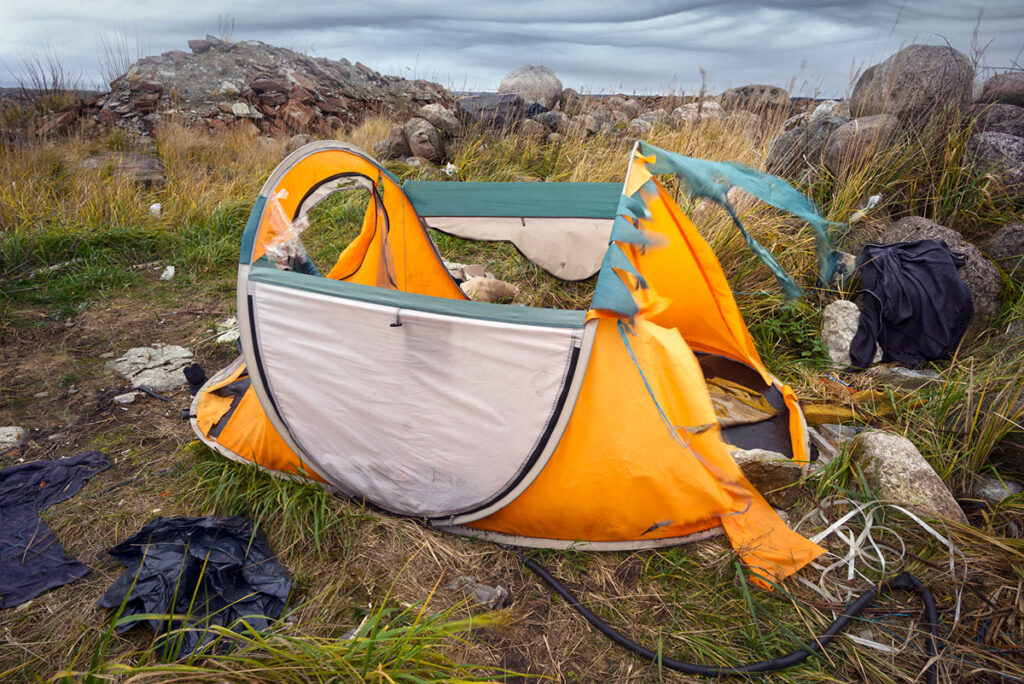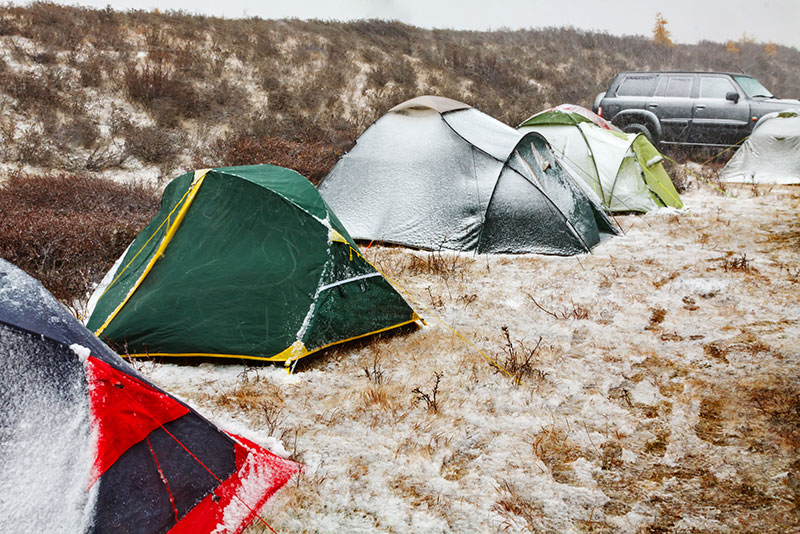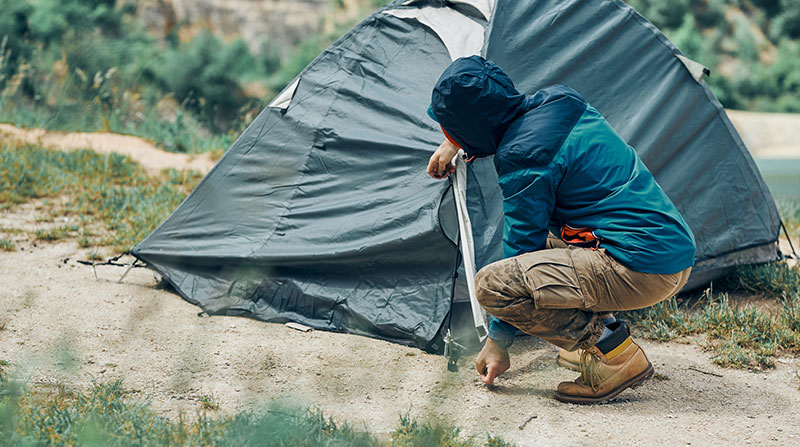
Camping in windy conditions can be are real challenge. There are several things you may have to consider, including the weather forecast. If the weather forecast is bad, a camper will need to take additional precautions to enjoy time at the camping site.
In general, most campers are afraid of camping in bad weather conditions. Even someone who encounters harsh weather conditions while camping has to deal with different difficulties. The reality, at least for me and our friends, is that some of our best memories camping are from bad weather times. It forces creativity and creates a sense of adventure. You remember the trip!
Still, following some simple techniques will help the campers to withstand harsh weather conditions, even in high winds outside. Unlikely, most campers are not aware of these techniques.
Useful Tips for Camping in Windy Conditions
No one can deny that camping is challenging in heavy windy. However, the challenges can be lessened if you follow some basic tips.
1 – Choose an Open Area
Camping in an area surrounded by tall trees will be dangerous during windy conditions. The high wind can break tree branches at any time, falling into your camping tent.
This will cause painful injuries to you or other camp members, along with damage to the tent. In that case, choosing an open area where short shrubs are located will be the right option to prevent such challenges.
Short shrubs will help to lessen the effect of the wind, which prevents reaching high winds on your tent. This way, you can eliminate the damage that high winds can cause at your campsite.
2 – Pick the Right Tent
There are several types of camping tents you will find on both online and offline markers. Typically, tents are designed and made individually depending on the camper’s needs.
As you’re camping in windy weather, you will need heavy duty tents to live in that can survive storms and harsh conditions. Heavy-duty tents are usually strong enough to resist what mother nature can throw at it. Apart from that, small-diameter tents will be safer for you to withstand windy weather. Some of the best tents designed for windy conditions are mountaineering tents, as they are built for above tree line, high altitude camping where wind is strongest.
This is because the smaller area of the tent will provide better resistance against the wind. However, if you are camping with a group, choosing small-footprint tents will be ideal for resisting high winds. In some cases, the bushcrafter using a tarp might even fair better if he/she knows how to use it properly. See my tent vs tarp article as look at how high winds impacted both.
3 – Set Up the Tent Properly
Setting up your tent will determine how well the tent will withstand high wind. This is because a sudden and strong wind will create adverse conditions for you if you do not properly set the tent.
For example, if the tent stakes are not driven into the ground properly, the storm will pull them up. Apart from that, flaps will be released with the effect of friction. So, setting up your tent properly is crucial to ensure safe camping in windy conditions.
In that case, you should ensure the stakes of your tent are driven deep at each corner, and the flaps are tight. However, if you are unaware of setting up a tent in windy conditions, check out the procedure discussed in the last section.
In winter conditions in the mountains, mountaineers will actually dig into the snow and use the snow they’re digging up to build walls around their tent. This cuts the wind tremendously. Depending on your camping situation, you could do something similar. For example, park your vehicle on the side of the tent facing the brunt of the wind.
4 – Consider Removing the Rainfly from Your Tent
Having a waterproof tent is very useful for keeping you or your gear dry while camping in heavy rain. However, during harsh weather conditions, the rainfly assists in pushing the tent with the effect of the wind. Basically, rainflies cause additional wind power over your tent. So, it might be better to remove the tent’s rainfly before the strong wind.
You need to test this, however. Each situation is different. In some cases, the wind entering the tent through screened windows could create internal wind pressure.
5 – Don’t Light a Fire
Lighting a fire is dangerous when there is a strong wind. Even a small flame can be renewed with a sudden wind, never mind the fact sparks can be blown into the wind far away from the campsite.
6 – Keep an Eye on the Weather Forecast
There are preppers-can-forecast-the-weather/” target=”_blank” rel=”noreferrer noopener”>ways you can predict the weather, but technology makes this easier. Now anyone can easily check out the weather forecast on the internet anytime. So, before going on a camping trip, you should check the weather conditions at your camping site.
If you find a probability of storms, you should carry the necessary things to survive the stormy weather. Even if you fall into harsh weather during camping, take the necessary actions that will help you fight against the bad weather.
7 – Camp with Others
Camping in windy weather conditions can be risky, especially if you go alone. In that case, camping with groups will allow you to support each other during bad weather conditions. For example, if you tried to set up a tent alone in the wind, think about how much easier it will be when several hands help you.

Besides, camping with friends lets you encourage one another, even if there is a strong wind outside. So, before going on any trip, invite some of your friends.
How to Set Up a Tent in Windy Conditions
Setting up a camping tent in windy conditions is simple but requires following the proper method. Otherwise, you will fall into deep trouble during windy weather conditions. Below, we have covered step-by-step instructions in this regard.
1 – Assemble Your Tent Poles
As mentioned earlier, choosing an open space away from tall trees will be better for camping in windy conditions. Once you have selected the right place, unpack the tent’s poles and assemble them. Then, arrange the poles that can be easily accessed and unpack the tent stakes for later use.
2 – Lay Out Your Tent
At this stage, you will need to examine the wind direction. In general, setting up a tent at the narrowest end facing the wind is good for withstanding strong winds. In contrast, if you set up your tent facing the door in the wind, it will be difficult for the tent to stay standing.
So, hold the tent with one side facing the wind while the other side against the wind. This way, the wind will allow the tent to carry the rest of the position.
3 – Stake Windward Corners
Now, stake down the two windward corners and ensure the tent is spread as far and wide as possible. This will help the tent get an optimal structure after setting up completely.

However, don’t hammer the stakes at a 90° angle into the ground while staking. In that case, you should hammer the stakes at a 45° angle to the ground. This will help the stakes adhere to the ground, preventing pulling out even if the wind pushes the tent.
4 – Fasten the Poles
Once you have hammered the stakes, place the poles on top of the tent to prevent it from flying away. Then, attach one pole at the windward corner you have just staked to the ground.
Following this procedure, attach all the remaining poles to the tent’s stakes. After attaching the poles, attach the sides of the tent to the poles with the fasteners.
5 – Guy Out Your Tent
To guy out of the tent, use stakes or heavy weights to anchor the guy line away from the pole. Some tents have additional built-in ties or fasteners to tighten the guy line.
However, it is better to anchor the guy line for better stability. This will help minimize the noise level produced due to the fabric flapping in the wind.
Summary
Camping in windy weather conditions can be challenging for anyone. However, you can overcome the challenges by following the tips discussed above. These tips will assist you to stay inside the tent even if there is a strong wind outside at your campsite.
In general, most campers experience different issues during strong winds due to improper tent setup. For that, we have explained step-by-step instructions on how to set up a tent in windy conditions.
Following the mentioned steps, you can easily set up your tent, providing maximum protection against windy weather conditions.

